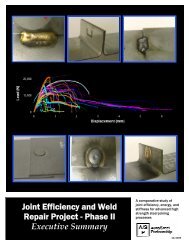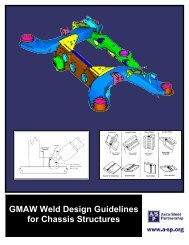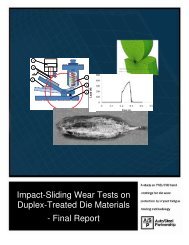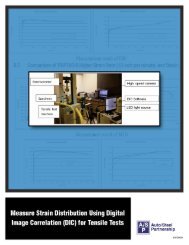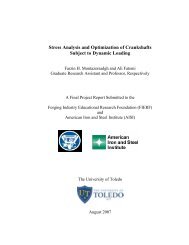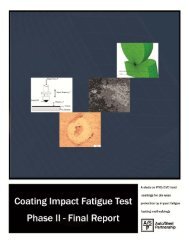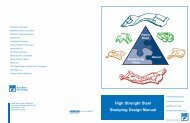Light Truck Frame Joint Stiffness Study Phase 1 Final Report
Light Truck Frame Joint Stiffness Study Phase 1 Final Report
Light Truck Frame Joint Stiffness Study Phase 1 Final Report
Create successful ePaper yourself
Turn your PDF publications into a flip-book with our unique Google optimized e-Paper software.
EXECUTIVE SUMMARY<br />
Background<br />
There is little published information available to frame designers on the relative stiffness of the joints in a<br />
light truck frame. A survey of current production frames found that most frames used joint styles from a<br />
group of approximately 15 joints. Many joints had obvious packaging or manufacturing-driven constraints,<br />
but the relative merits of each joint type is not well documented or available in a form useful for frame<br />
designers. The A/SP <strong>Light</strong> <strong>Truck</strong> <strong>Frame</strong> committee felt that a study to determine relative stiffness of the<br />
joints, along with a tool to communicate the results of the study to frame designers, would allow better<br />
decisions to be made at the concept design phase and would facilitate lighter weight frame design.<br />
Project Goals<br />
The goal of this program is to provide the frame designers with data and tools to facilitate early concept<br />
choices for frame joints that promote more efficient, and lighter weight steel designs. The <strong>Frame</strong> <strong>Joint</strong><br />
Toolbox resulting from this program takes the form of an interactive worksheet a designer can use to<br />
investigate the choices of different joint designs, and varying parameters within a design.<br />
In order to achieve the goal, the scope of the project involves the following steps:<br />
• Research and organize existing information available on joint stiffness<br />
• Develop methods to characterize joint stiffness and evaluate analytically using finite element analysis<br />
• Perform physical tests on multiple (three) samples of five joint types<br />
• Correlate the physical testing and finite element analysis<br />
• Evaluate the sensitivity of the joint stiffness to the various joint parameters<br />
• Create the <strong>Frame</strong> <strong>Joint</strong> Toolbox that incorporate design rules and the sensitivity analysis<br />
Project Results<br />
Based on the literature search, and newly developed methods, a process was developed to evaluate the<br />
stiffness of a side rail to crossmember joint, and an interactive <strong>Frame</strong> <strong>Joint</strong> Toolbox was developed to<br />
document the program results, and provide a mechanism for frame designers to utilize the data in the<br />
design process. The joint stiffnesses varied from 0.116 KNm/deg to 50.429 KNm/deg and the mass of the<br />
joints ranged from 4.68 kg to 7.01kg. The Toolbox is based on an interactive spreadsheet. The<br />
spreadsheet allows the designer or engineer to modify the geometric and gage properties of the joint<br />
members, and calculates joint stiffness and relative mass based on the new properties.<br />
<strong>Report</strong>: A/SP-005-1 <strong>Light</strong> <strong>Truck</strong> <strong>Frame</strong> <strong>Joint</strong> <strong>Stiffness</strong> <strong>Study</strong> 2



